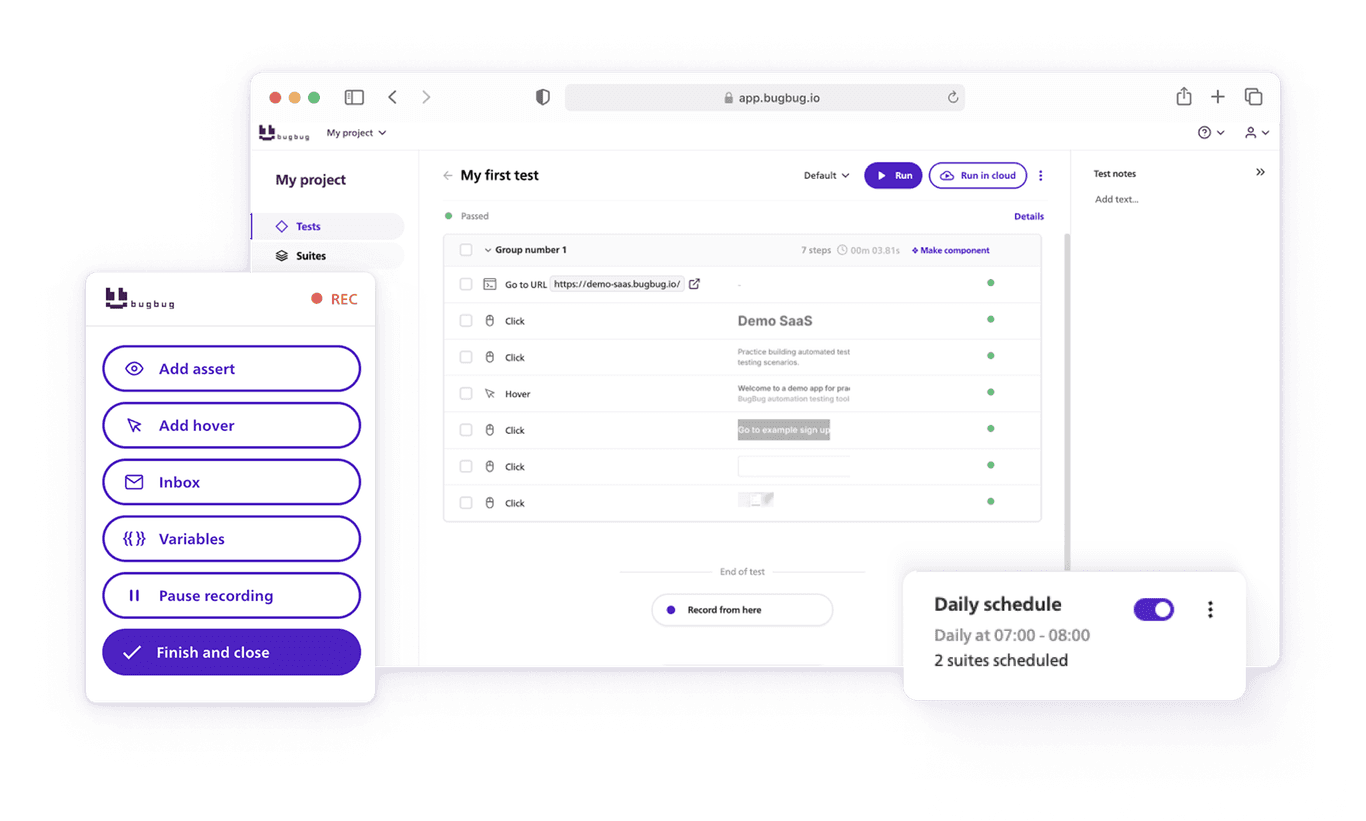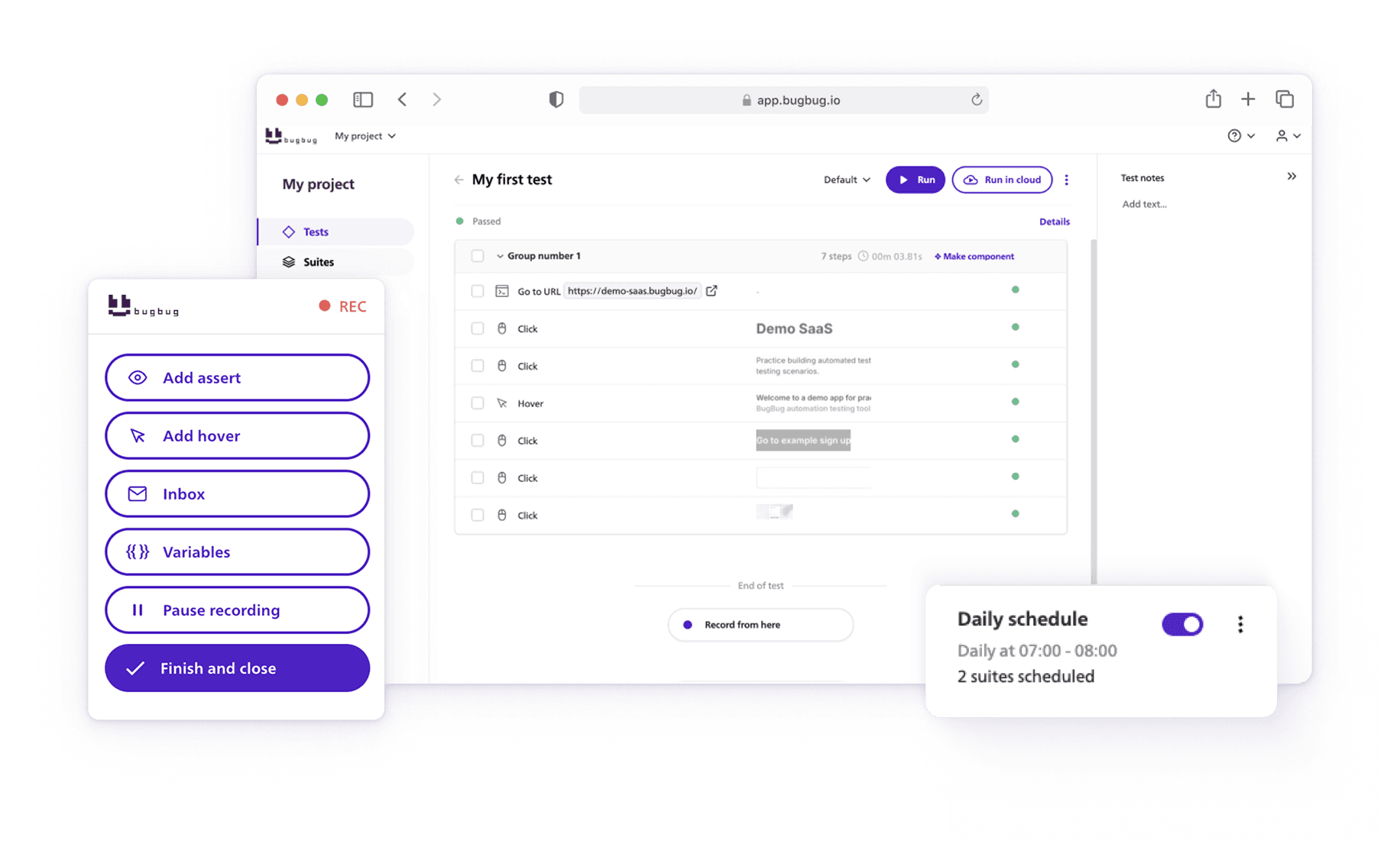🤖 Summarize this article with AI:
💬 ChatGPT 🔍 Perplexity 💥 Claude 🐦 Grok 🔮 Google AI Mode
This guide walks you through a structured game plan for what to test right after launch and how to keep testing alive over time. You’ll learn how to set up smoke checks, cross-browser baselines, performance snapshots, and regression cadences.
We’ll then dive into how to implement it all using BugBug, a no-code Chrome-based end-to-end testing tool, and show how to integrate schedules, alerts, and CI/CD gates. Finally, you’ll find ready-made suites, variable templates, and practical examples you can adapt to your own staging and production environments.
- 🎯 TL;DR - Post Launch Testing Game Plan
- How to do all that with BugBug (HOW to implement)
- 1) Record the critical journeys (minutes, no code)
- 2) Structure tests into Suites
- 3) Prove they work in the cloud
- 4) Add Schedules (your 24/7 monitors)
- 5) Turn on alerts
- 6) Gate deploys with CI/CD
- 7) Keep tests production-ready (reduce flake)
- Ready-made suites & checks (copy the idea, implement in BugBug)
- Suite: Core Journeys—Prod (hourly)
- Suite: Auth—Prod (nightly)
- Variables & environments (quick templates)
- Monitoring & alerting patterns
- Flake-resistant design checklist
- Your next moves (straight to done)
🎯 TL;DR - Post Launch Testing Game Plan
- Start simple with smoke checks: Record core user flows (home, login, signup, conversion, health) using BugBug’s Chrome recorder, no coding required.
- Organize tests into suites: Group scenarios (Smoke, Core Journeys, Auth) for easier scheduling, parallel runs, and environment management.
- Run in the cloud & schedule tests: Move execution off your laptop; set frequent runs (every 5–10 min for Smoke, hourly for Core Journeys, nightly for Auth).
- Enable alerts & CI/CD gates: Connect Slack/webhooks for failure notifications and integrate with GitHub Actions or CI pipelines to block bad deploys.
- Keep tests stable & reusable: Use BugBug’s auto-selectors, add “page ready” assertions, exclude experiments, and reuse components like login or checkout flows.
Check also:
How to do all that with BugBug (HOW to implement)
Choose user-friendly, codeless tool
Test easier than ever with BugBug test recorder. Faster than coding. Free forever.
Get started
1) Record the critical journeys (minutes, no code)
- Install the BugBug Chrome recorder and record flows (login → do X → assert Y). You can create reliable end-to-end tests without writing code.
- Add assertions as you record (text present / element visible) so failures map to user-visible issues.
- Use Variables for base URLs, emails, product names; reference as {{baseUrl}}, {{uniqueEmail}}.
- Optional: Built-in inbox testing accelerates signup/reset flows (email capture/confirmation).
2) Structure tests into Suites
Create suites like:
- Smoke—Prod (P0s only)
- Core Journeys—Prod (search, profile, payments, i18n)
- Auth—Prod (login, reset, SSO)
Suites run tests in parallel, can be scheduled, and help manage environments.
3) Prove they work in the cloud
After local playback, switch each test/suite to Run in cloud—this moves execution off your laptop and is required for scheduling.
4) Add Schedules (your 24/7 monitors)
From Schedules → New schedule, pick Every 5 minutes / Hourly / Daily / Weekly / Monthly. Start with:
- Smoke—Prod: every 5–10 minutes
- Core Journeys—Prod: hourly at :15
- Auth—Prod: nightly
No infra or CI needed to schedule.
5) Turn on alerts
- Slack: send failures to a channel/DM.
- Webhooks: post to incident bots, ticketing, or on-call routers; you can include built-in variables like {{testRunId}}.
6) Gate deploys with CI/CD
- GitHub Actions: official action runs BugBug tests/suites in the cloud (paid plans). Use it post-deploy (or as a gate) to auto-fail/rollback. GitHub
- API/CLI: trigger specific tests/suites with environment variables from any CI.
7) Keep tests production-ready (reduce flake)
- Prefer BugBug’s auto-selectors; add explicit ready assertions (e.g., “Dashboard” visible) to tame dynamic UIs.
- A/B tests & experiments: exclude BugBug cloud runner IPs (or your local IP) from experiments to avoid DOM drift.
- Use Step groups/components to reuse common flows (login, add-to-cart) and keep suites tidy.
Ready-made suites & checks (copy the idea, implement in BugBug)
Suite: Smoke—Prod (every 5–10 min)
-
Home renders
Go to / → assert hero heading text exists.
-
Login
Visit /login → enter creds (from {{smokeUser}}) → submit → assert username visible.
-
Primary conversion
Add product → checkout (test/sandbox) → assert confirmation number.
-
Health endpoint
Open /status → assert JSON contains "ok": true.
-
Cookie banner
Accept → assert preference stored (cookie/localStorage) and UI remains usable.
Implementation notes:
Suite: Core Journeys—Prod (hourly)
- Signup with {{uniqueEmail}} → verify confirmation email → first-login checklist. (Use inbox feature.)
- Search/filter/sort: assert count/ordering changes.
- Profile update: update avatar/settings → reload → assert persisted.
- Payment fallback: try a “declined” card → assert friendly error.
- Locale switch: change language → assert translations persist.
Suite: Auth—Prod (nightly)
- Password reset flow (email link).
- SSO (if applicable).
- Session expiration → re-auth prompt.
Variables & environments (quick templates)
Project variables
- baseUrl → https://app.example.com
- stagingUrl → https://staging.example.com
- smokeUser / smokePass
- uniqueEmail → generated per run (BugBug can set variables at runtime)
Use them in steps as {{baseUrl}}/dashboard or input fields.
Per-suite overrides
- Run Smoke against prod but the same suite can target staging by swapping {{baseUrl}}. Suites are explicitly designed to support multiple environments.
Monitoring & alerting patterns
- Channel alerts: Slack channel for Smoke—Prod; team DMs for Auth—Prod nightly results.
- Incident automation: Webhook to your incident platform with {{suiteName}}, {{testRunId}}, failure URL; auto-open a Sev-2 ticket.
- Noise control: Alert only on consecutive failures or set a “cool-down” in your receiver (done on the webhook consumer side).
Flake-resistant design checklist
- Add an assertion after each navigation (“page ready”).
- Stabilize experiments (disable or pin variant for runner IPs).
- Reuse step groups/components for login, search, checkout.
Also, check how to fix flaky tests!
Choose user-friendly, codeless tool
Test easier than ever with BugBug test recorder. Faster than coding. Free forever.
Get started
Your next moves (straight to done)
- Record 5 tests: home, login, signup, conversion, health.
- Add variables ({{baseUrl}}, users).
- Put them into Smoke—Prod; Run in cloud; ensure they pass.
- Create a Schedule: every 5–10 minutes; connect Slack + Webhook.
- Wire CI to run Smoke after each prod deploy using the GitHub Action (or API/CLI).
⚡ By following these steps, you’ll have an automated safety net that validates your app’s most critical journeys within minutes of each deploy and keeps monitoring them around the clock.
Happy (automated) testing!



